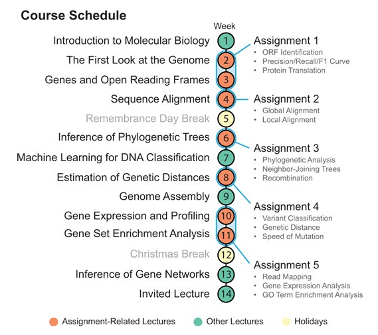The Ultimate Guide To Bioinformatics Tutor
Unknown Facts About Bioinformatics Tutor
Table of ContentsThe Ultimate Guide To Bioinformatics TutorThe 20-Second Trick For Bioinformatics TutorSome Of Bioinformatics TutorNot known Details About Bioinformatics Tutor Some Ideas on Bioinformatics Tutor You Need To Know
Of the total amount participants associated with the training, 80% were pupils from public college organizations, while the remaining 20% came from private institutions. To receive a certificate of engagement, students were called for to participate in at the very least 90% of the overall training hours. As an outcome of this need, an excellent 95% of the participants effectively acquired their certificates, having not just fulfilled the minimum presence standards but also finished all assigned activities throughout the training.
Throughout the height of the COVID-19 pandemic, specifically in between June and August 2020, the job group was charged with organizing specialized training in bioinformatics. This training was especially focused on pupils from the study group Nucleus for Research study in Applied Computing at the Federal College of Pará (UFRA) The adjustment to remote understanding platforms as a result of the pandemic developed an opportunity to explore brand-new mentor techniques and electronic tools that boosted both reach and performance.
To react to the expanding demand in the computer and life sciences fields, an advanced course was presented in 2020 labelled Intro to Artificial intelligence. This program was developed to supply an accessible yet detailed summary of Expert system methods, specifically as applied in bioinformatics. The program was accomplished over 3 months, from October to December 2020, and was supplied totally online via the Google Meet system. This virtual style made it possible for involvement from trainees across Brazil, a number of whom might not have had the possibility to go to in-person sessions.
The Facts About Bioinformatics Tutor Uncovered
About 50% of the total training hours were devoted to practical tasks where trainees built smart designs and applications in an array of scientific domain names, consisting of genetics, molecular biology, and ecological information analysis. These systems made it possible for students to involve in real-time data adjustment, design training, and algorithm experimentation.
Sixty of them were connected with numerous higher education establishments in the state of Pará, while the staying twenty came from institutions located in five various other Brazilian states. By introducing Artificial Knowledge in a pertinent and practical context, the campaign offered to link the void between theory and real-world application, supplying pupils with a solid structure for future study or work in the area.
The training initiative developed component of a wider academic outreach effort understood as the Bioinformatics when driving project. This job has, for many years, presented dozens of students to the globe of bioinformatics and computational biology. The events held under this umbrella campaign have happened throughout several regions and years, as summed up in Table 1 (Checklist of occasions, areas, years, and complete varieties of students and teachers)
Several of these groups, originally brought together by their participation in training occasions, have actually given that gone on to produce independent clinical study in cooperation with local academic establishments. The training not just promoted scientific thinking within the context of bioinformatics however also stimulated joint partnerships that expanded past the training setting.
What Does Bioinformatics Tutor Mean?
The very same team, omitting IH and RR, also acted as tutors for the practical training components. Financing for the task was supplied via the grant 88887.200562/ 2018-00 from CAPES.
The Federal College of helpful resources Pará's Workplace of Study (PROPESP/UFPA) likewise provided economic assistance, especially for the manufacturing of the last manuscript. The writers declare no commercial or economic disputes of rate of interest that could have influenced the research. Additionally, all interpretations and point of views shared in this short article are solely those of the authors and do not necessarily show those of their corresponding establishments, the author, editors, or customers involved in the publication process.

Things about Bioinformatics Tutor
From a pedagogical point of view, the mentor strategy used in the training was intentionally interactive. Courses were conducted in a way that urged trainee participation and discussion, surpassing memorizing memorization to discover exactly how concepts are established, applied in life, and evaluated in scholastic settings. The instructional viewpoint focused on supporting both strong and having a hard time trainees, providing customized assistance, and building self-confidence with sustained mentorship and persistence.

Each group, consisting of around 36 individuals, was sustained by 3 coaches-- a lot of whom were visit the website postdoctoral researchers with specialized competence. These coaches not only assisted design the team tasks yet also facilitated their execution, making certain that each research inquiry was both properly challenging and pertinent. The goal was to give a naturally sensible context that individuals can discover with open-ended goals and accessibility to curated datasets.
For additional insights into the method and results of this project-based knowing technique, viewers are routed to S1 Text, which consists of in-depth descriptions of the pedagogical structure, examination techniques, and job themes used in the training sessions.
Some Known Incorrect Statements About Bioinformatics Tutor
Of the total individuals included in the training, 80% were trainees from public greater education establishments, while the continuing to be 20% came from private organizations. To qualify for a Full Article certification of engagement, students were required to participate in at the very least 90% of the total training hours. Significantly, past the trainees who enrolled in the training sessions, 7 knowledgeable trainers got involved in delivering the courses, while 3 dedicated research teachers coordinated the overall training procedure. Around 50% of the overall training hours were committed to sensible tasks where pupils built smart models and applications in a variety of scientific domain names, including genes, molecular biology, and environmental data analysis. The training not just fostered scientific reasoning within the context of bioinformatics yet also sparked collective partnerships that extended past the training environment.